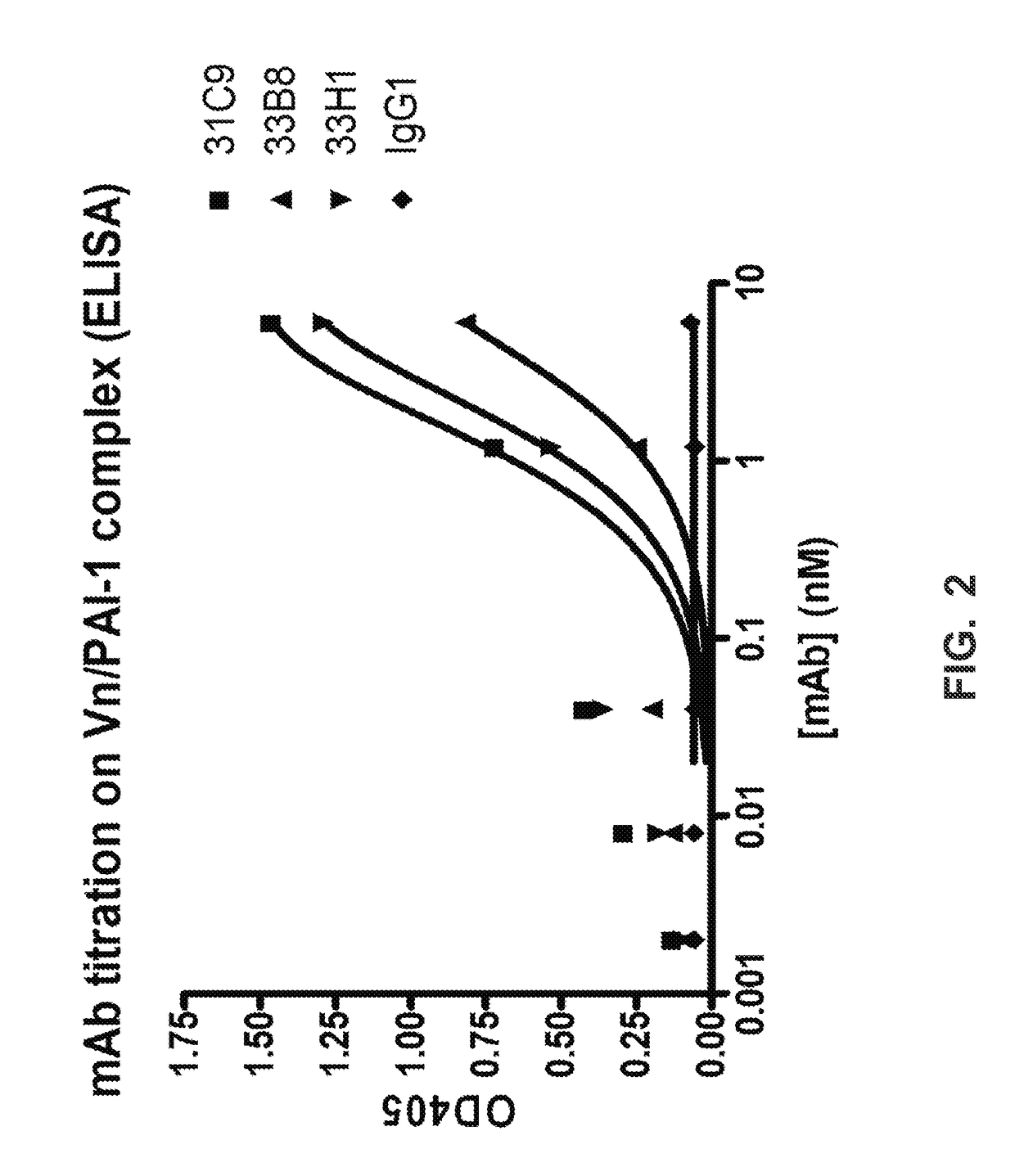Antibodies to plasminogen activator inhibitor-1 (PAI-1) and uses thereof
a technology of plasminogen activator and antibodies, which is applied in the field of antibodies to plasminogen activator inhibitors (pai1), can solve the problems of ineffective inhibition of 1 but not in the same way, and achieve the effect of restoring plasmin generation and facilitating the treatment of acute ischemic strok
- Summary
- Abstract
- Description
- Claims
- Application Information
AI Technical Summary
Benefits of technology
Problems solved by technology
Method used
Image
Examples
example 1
Hybridoma Generation: Immunization of Mice with PAI-1 Protein and Antibody Generation
[0270]Antibodies were developed that would be cross-reactive to human (h) and cynomolgus (cyno) monkey active PAI-1 (glycosylated or non-glycosylated form) and that would neutralize the inhibitory activity of PAI-1 and restore downstream production of plasmin thereby being an effective therapeutic for treatment of kidney, liver or lung fibrosis or prevention of abdominal adhesion formation and keloid scar formation. Neutralization of PAI-1 inhibitory function by monoclonal antibodies has been described to fall under three mechanisms: (1) blocking PAI-1 to tPA or uPA by steric hindrance, (2) converting PAI-1 into a latent conformation, or (3) converting PAI-1 into a substrate conformation.
a) Antigens
[0271]PAI-1 is secreted from the cells in an active conformation stabilized by its binding with subnanomolar affinity to vitronectin. PAI-1 undergoes spontaneous conformational change from active conforma...
example 2
Binding ELISA for Hybridoma Supernatant Screening for Specificity to PAI-1-Vitronectin Complex
[0284]Each fusion from the spleens of the five mice selected resulted in about 5000 clones that needed to be screened for binding to PAI-1 / Vn complex as a first-step primary screen. Primary screening of the hybridoma supernatants was performed in parallel using ELISA against either PAI-1 or PAI-1-Vitronectin complexes to select hybridomas binding specifically to PAI-1 complexed to Vitronectin. The materials used for the ELISA were the following: Immulon 4 HBX ELISA plates (Dynax cat #N054121.6); human monomeric Vitronectin at 5 ug / ml (Innovative Research cat #IHVN); glycosylated human PAI-1 (active form) (Molecular Innovations cat #GLYHPAI-A); non-glycosylated mouse PAi-1 in some fusions (Molecular Innovations cat #MPAI-A); a secondary antibody that was HRP-goat anti-mouse IgG (H+L) (Jackson ImmunoResearch Labs #115-035-166); and, ABTS substrate: Roche Diagnostics (#11 204 521 001).
Control ...
example 3
Biacore Screening of Hybridoma Supernatants by Affinity Ranking
[0291]Further selection of a high affinity antibody with low off-rate was performed by Biacore. Biacore hybridoma supernatant screening was performed either by: (1) reverse screening using anti-mouse immobilized anti-PAI-1 antibodies or (2) forward screening assay using free PAI-1 as a ligand or against immobilized Vn.
[0292]The instruments used were the BIACORE 2000 or BIACORE 3000 (GE Healthcare), designed for biomolecular interaction analysis (BIA) in real time. The sensor chip used was the CM5 chip (GE Healthcare) with carboxymethylated dextran matrix on the surface. Each sensor chip has four parallel flow cells (Fc). Every flow cell was coupled with anti-mouse IgG Fc mAb via standard amine coupling according to the manufacture's protocol for chip preparation.
[0293]In the Biacore reverse screening assay, ELISA positive hybridoma supernatants were selected and filtered through 0.2 μm filters before being injected onto ...
PUM
| Property | Measurement | Unit |
|---|---|---|
| time | aaaaa | aaaaa |
| time | aaaaa | aaaaa |
| time | aaaaa | aaaaa |
Abstract
Description
Claims
Application Information
 Login to View More
Login to View More - R&D
- Intellectual Property
- Life Sciences
- Materials
- Tech Scout
- Unparalleled Data Quality
- Higher Quality Content
- 60% Fewer Hallucinations
Browse by: Latest US Patents, China's latest patents, Technical Efficacy Thesaurus, Application Domain, Technology Topic, Popular Technical Reports.
© 2025 PatSnap. All rights reserved.Legal|Privacy policy|Modern Slavery Act Transparency Statement|Sitemap|About US| Contact US: help@patsnap.com



